On the evening of April 18, ByteDance initiated beta testing for Coze, an agentic artificial intelligence platform. Though the release was low-key, usage spiked within hours, pushing the platform beyond its allocated compute resources.
The surge validated a key hypothesis among the Coze team: users are eager for an AI system that contributes meaningfully to actual work tasks.
ChatGPT popularized the chat interface as the default mode for interacting with large language models (LLMs), based on the premise that natural language should replace traditional menus and buttons. ByteDance took a similar approach when it introduced Coze in mid-2023. The platform aimed to let developers, regardless of technical background, build applications by integrating their data with advanced AI models.
By early 2024, thousands of chatbot-style apps had emerged, addressing a range of use cases from information queries to emotional support. Yet, many of them faced the same issues: user acquisition was difficult, and retention proved even harder.
The team identified a fundamental mismatch between format and need. While chatbots are easy to use, it also demands more from the underlying model. As a result, only a few general-purpose chatbots gained real traction in China and the US.
One exception stood out. AI applications embedded within user workflows—targeted solutions for specific tasks—showed stronger metrics in both user growth and engagement. This insight drove a shift in focus at Coze: from general-purpose chatbots to agents designed to handle task-specific problems within structured workflows.
That shift aligned with a broader industry movement. As more powerful models like OpenAI’s o1 model and Anthropic’s Claude 3.5 Sonnet entered the market, and tools like Cursor and Devin demonstrated how agents could manage complex tasks, competition in the space intensified. The likes of Manus and Genspark all joined the race. ByteDance responded with its own project, which eventually became Coze.
Coze runs on in-house models, including Doubao. It supports the Model Context Protocol (MCP) and integrates with Lark (known domestically as Feishu), particularly its Docs and Sheets applications. Central to its offering is a general-purpose interface augmented by a system of template agents tailored to specific tasks.
LatePost gained early access to the beta and tested the platform across a variety of tasks. The insights that follow are based on the Chinese version of Coze, which operates independently of its international counterpart. As such, the user experience outside of China may differ.
The beta is positioned as a technical demonstration of how AI agents can contribute meaningfully to professional tasks. ByteDance’s broader ambition is to build an open system where users state their needs and the platform automatically identifies the most suitable agent—or combination of agents—to complete the task. The current version is still in an early phase.
The following insights are drawn from LatePost’s tests on the Chinese version of Coze, which runs on a separate domain from its international counterpart. As such, the user experience may vary for users outside China.
Coze: A general-purpose “intern” and a panel of domain experts
Coze’s general-purpose agent operates in two distinct modes: exploration and planning.
In exploration mode, the agent executes tasks based on user input, functioning similarly to other AI tools on the market. Planning mode, by contrast, emphasizes collaboration. Instead of acting immediately, the agent generates a step-by-step plan, presents it for user approval, and continues to seek input throughout execution. In practice, planning mode has proven more effective for handling complex assignments.
This approach aligns closely with OpenAI’s “Deep Research,” which also encourages users to refine and clarify tasks before execution. A Coze team member described the general-purpose agent as akin to “an inexperienced intern” who’s capable of delivering results, but often reliant on iterative feedback to stay aligned with user expectations.
This analogy held up during LatePost’s testing. The agent demonstrated the ability to interpret prompts, scan public data, and produce draft outputs that were directionally useful. For example, when tasked with compiling recent changes to the Doubao team, it identified leadership shifts and structural adjustments, such as the merging of the “AI lab” into the “seed” team.
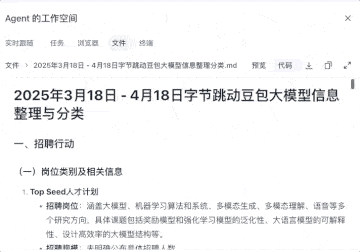
In another task, the agent was asked to design a hydration reminder app. It began by reviewing leading market apps and breaking down their features, then requested user-specific requirements. Based on the input, it generated a full development plan and delivered a downloadable prototype via an interactive local webpage.

In more demanding scenarios—like when asked to identify US tariff rates on items such as T-shirts, bibles, sneakers, antibiotics, and vitamin C supplements—the agent attempted to retrieve data from government sources. It returned accurate results for two items, but the rest were outdated. A parallel test using OpenAI’s Deep Research produced slightly better, though still incomplete, results.
In most cases, Coze automatically generated a visual summary in the form of an interactive local webpage, even when not explicitly instructed to do so. “In today’s world, people’s attention is fragile. What you show first has to make an impression,” said one Coze team member. To complement this, agents also produce longer reports for users seeking more in-depth analysis.
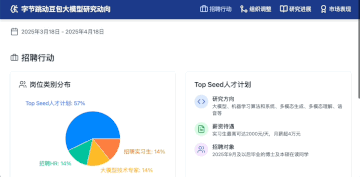
To support specialized tasks, Coze also includes a growing library of domain-specific agent templates. At the time of testing, the beta version included two template agents: one designed to conduct user research, and another focused on analyzing third-party financial data.
The user research agent originated from an internal ByteDance workshop. Recognizing that product teams routinely conduct user analysis, the Coze team worked with experienced researchers and product managers to codify effective practices. The goal was to enable the model to learn these workflows and apply them independently.
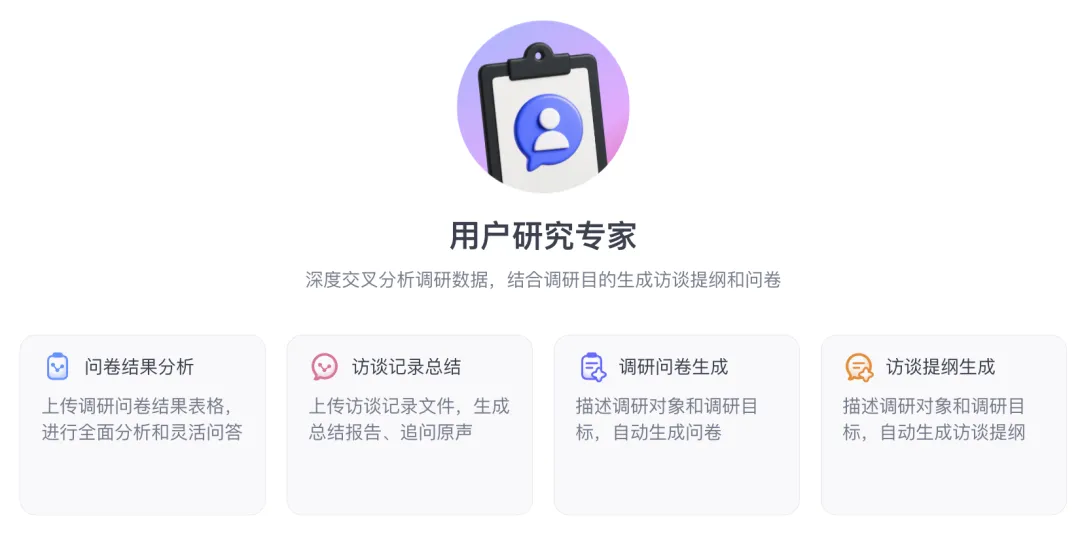
When tested on a dataset of user interviews about smart glasses, the agent surfaced recurring themes and proposed design suggestions. One key insight—favoring subtle, unobtrusive aesthetics—emerged from repeated but indirect references, such as users describing the glasses as suitable for “sneaky breaks at work.”
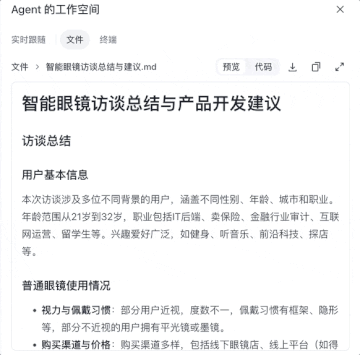
The agent also includes data processing capabilities. When users upload CSV files, the system converts them into cloud-hosted databases, enabling it to conduct analysis according to user-defined queries.
The second agent—a stock market assistant—was developed with Huatai Securities. It is trained to analyze Chinese public companies and assess growth potential, drawing on a specialized financial database to minimize inaccuracies. When asked to assess the impact of US-China tariffs on CATL, the agent broke the task into six phases: researching the trade dispute, understanding tariff mechanisms, collecting stock data, analyzing trends, projecting outcomes, and drafting a report.

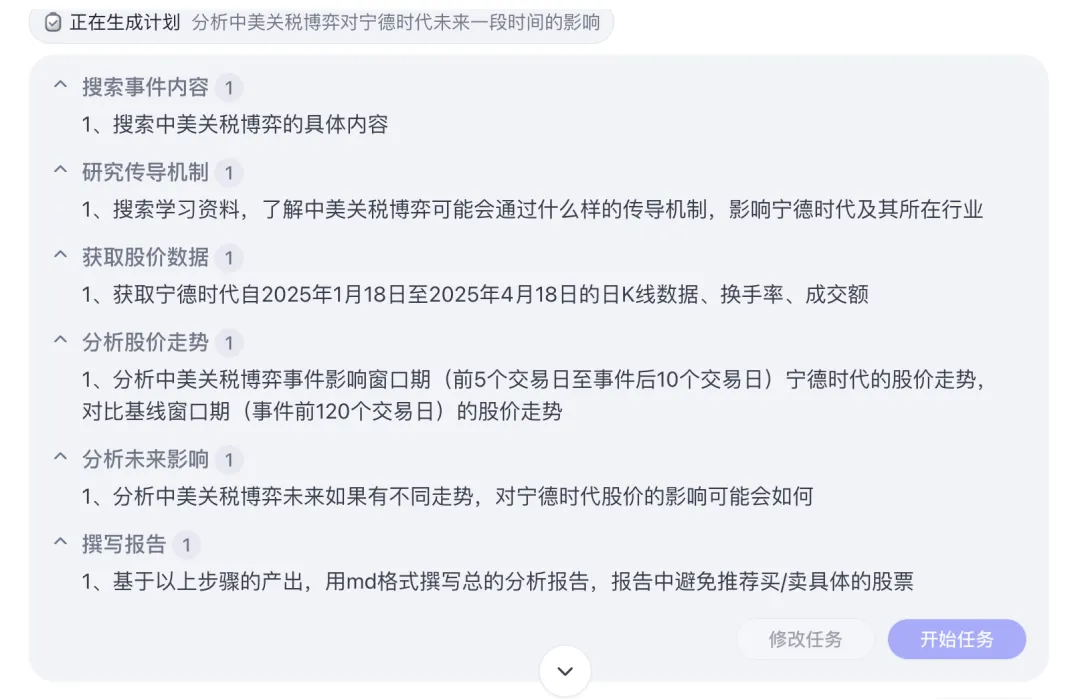
The result was a comprehensive analysis, delivered in about 40 minutes. It covered potential impacts on raw material sourcing and export strategy and recommended actions such as expanding into new markets and investing in cost-efficient, high-density battery technology. While most findings were accurate, a few hallucinations were noted.
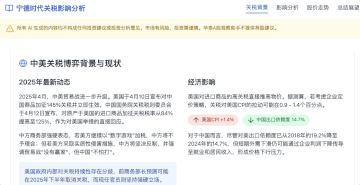
Integrating Coze and Lark to develop new products
The Coze team approaches product development with a pragmatic philosophy. Rather than attempting to maximize the capabilities of large models at this early stage, its mandate is to solve real-world workflow problems.
“Coze is an open platform. If there’s a domestic model better than Doubao, we will actively integrate it,” a team representative told LatePost. During early development, Doubao’s “Deep Thinking” capability had yet to launch. The team initially considered DeepSeek-R1 but found its tool invocation abilities insufficient during testing.
Following comparisons across six Chinese-developed models, ByteDance selected several to support the platform, with Doubao 1.5 Pro as the primary model. It excelled in instruction following, multimodal processing, and tool invocation, while maintaining low inference costs—key for scalability.
Coze also benefits from ByteDance’s extensive internal ecosystem. Drawing on feedback from more than two million AI applications and millions of developers, the team can identify trends early. Integration with ByteDance’s infrastructure, including Volcano Engine, supports rapid iteration and deployment across platforms such as Doubao, Lark, and Douyin mini programs.
While this ecosystem does not generate new products outright, it enables rapid validation of promising ideas. In the second half of 2023, the team pivoted from chatbot development to workflow automation, positioning Coze as a platform that fosters human-agent collaboration, supported by relevant data.
One tool that supports this shift is Coze Luopan, a debugging system built to oversee large model applications. Luopan tracks development, fine-tuning, and deployment, helping the team optimize performance and learn from each iteration. It has been instrumental in accelerating the development of sophisticated agent features.
Coze also has an edge in building collaborative features. While many AI tools on the market now integrate with Lark, most MCP (Model Context Protocol) implementations remain limited to API interactions. MCP, introduced by Anthropic in 2024, provides a standardized interface for large models to interact with software, bridging traditional apps and AI systems. Though many companies use MCP to augment their own tools, few have built MCP-ready software designed for broader integration.
This is where ByteDance’s position proves advantageous. The Coze team has converted Lark’s Docs, Sheets, and Base apps into callable tools. With user authorization, agents can read and write directly within Lark documents, eliminating manual uploads and streamlining workflows. Agents can also access internal documentation the user has permission to view, enhancing automation for workplace tasks. Secure access to private data is widely recognized as a key differentiator in agent capability.
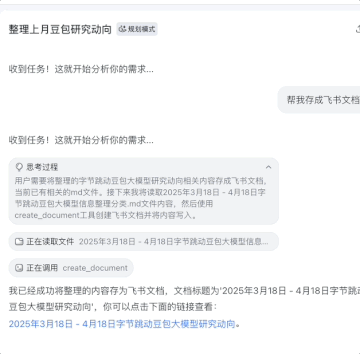
As access to foundational models becomes more standardized, differentiation is shifting toward integration depth and data availability. Open-source technologies have narrowed the field on model performance. The true competitive edge now lies in whether an agent can effectively tap into proprietary tools and high-value data.
This perspective also shapes how the Coze team views progress. Emphasis is not placed on releasing a perfect product, but on building a system that responds to user feedback. “Timing is everything,” one representative said. Releasing the beta was seen as a necessary step to gather insights and iterate quickly.
The broader AI community increasingly agrees that expanding user bases alone does not improve model performance. Claude 3.5 Sonnet and DeepSeek-R1, for example, were launched before reaching large-scale adoption. But while foundational models improve primarily through data loops, agents operate at another level—where user interaction with systems is central to their development.
“Real user feedback is crucial,” the Coze team noted. “It informs feature refinement, improves user experience, and makes better use of foundational models.”
Coze’s roadmap reflects these priorities. Analysis of platform data shows that many applications built with Coze meet highly specific needs. Though usage is concentrated in smaller user groups, the frequency of use remains steady. This reflects the “fat tail” distribution described by financial theorist Nassim Taleb: long-term relevance among niche audiences.
While future improvements in foundational models could absorb some use cases, highly personalized tasks are unlikely to be addressed by generalized systems. Coze aims to fill that gap by enabling collaboration between generalist and specialist agents—one reason the platform was named after the Chinese word for “space.”
Coze marks the beginning of ByteDance’s deeper engagement with agentic AI. Other major Chinese technology firms are following suit. The race is on, and ByteDance is already in motion.
This article was adapted based on a feature originally written by and published on LatePost. KrASIA is authorized to translate, adapt, and publish its contents.
